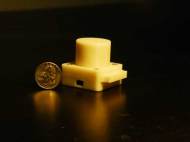UCLA engineer invents world’s smallest, lightest telemedicine microscope
 UCLA engineer Aydogan Ozcan, inventor of a novel lensless imaging technology known as LUCAS (Lensless Ultra-wide-field Cell Monitoring Array platform based on Shadow imaging), has now taken his work a step further by creating a miniature microscope – the world’s smallest and lightest for telemedicine applications. You can find more information in a paper published online in the journal Lab on a Chip.
UCLA engineer Aydogan Ozcan, inventor of a novel lensless imaging technology known as LUCAS (Lensless Ultra-wide-field Cell Monitoring Array platform based on Shadow imaging), has now taken his work a step further by creating a miniature microscope – the world’s smallest and lightest for telemedicine applications. You can find more information in a paper published online in the journal Lab on a Chip.
Instead of using a lens to magnify objects, LUCAS generates holographic images of microparticles or cells by employing a light-emitting diode to illuminate the objects and a digital sensor array to capture their images. The technology can be used to image blood samples or other fluids, in a cost effective manner. In addition to being far more compact and lightweight than conventional microscopes, it also obviates the need for trained technicians to analyze the images produced ― images are analyzed by computer so that results are available instantaneously.
Weighing 46 grams (approximately as much as a large egg) the microscope is a self-contained imaging device. The only external attachments necessary are a USB connection to a smart-phone, PDA or computer, which supplies the microscope with power and allows images to be uploaded for conversion into results and then sent to a hospital.
Samples are loaded using a small chip that can be filled with saliva or a blood smear for health monitoring. With blood smears, the lensless microscope is capable of accurately identifying cells and particles, including red blood cells, white blood cells and platelets. The technology has the potential to help monitor diseases like malaria, HIV and tuberculosis in areas where there are great distances between people in need of health care and the facilities capable of providing it. It can even be used to test water quality in the field following a disaster like a hurricane or earthquake.
Using a couple of inexpensive add-on parts, the lensless microscope can also be converted into a differential interference contrast (DIC) microscope, also known as a Nomarski microscope. DIC microscopes are used to gain information on the density of a sample, giving the appearance of a 3-D image by putting lines and edges in stark contrast. The additional parts for conversion to a DIC microscope cost approximately $1 to $2.
Operating the microscope is as simple as filling a chip with a sample and sliding the chip into a slot on the side of the microscope. Because of its large aperture, the lensless microscope is also resistant to problems caused by debris clogging the light source. In addition, there are few moving parts, making the microscope fairly robust.
The lensless microscope is also an example of a type of medicine known as telemedicine. In resource-limited settings, tools that are portable enough to do medical tests in the field are vital. Tools like the lensless microscope could be digitally integrated as part of a telemedicine network that connects various mobile health-care providers to a central lab or hospital, filling gaps in physical infrastructure with mobile tools.
“Making things user-friendly is what I love about being an engineer,” Ozcan said. “It is very rewarding to create something that to the end-user is very simple, when in reality years of research and work went into the technology and product development.”









Leave your response!